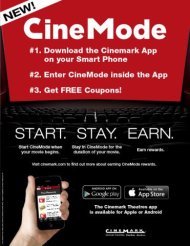Movie Theater Experience - Norming Deviant Customers
My wife and I went to the movies last night, something we rarely do. After all, with a big-screen TV and Netflix, one's home is a movie theater.
Before the movie started, the screen displayed an ad for a new service called CineMode. CineMode is an app for your smart phone that, when activated, puts your phone in a sleep mode. But here's the customer performance kicker. If your smartphone remains in CineMode for the entire length of the film, then you'll earn a reward. - a digital coupon for treats, movie discounts, and so on.
The whole aim of CineMode is to influence customer performance, specifically that of deviants who text and do other things with their phones that impact the quality of the customer experience for other movie goers. Obviously, setting customer expectations didn't work. So some stronger medicine was needed. However, after displaying the CineMode ad, the theater then displayed a stronger message: if you use your phone in the theater during the movie you will be asked to leave. Which incentive do you think will be more effective? The CineMode reward or the threat of removal from the theater?
In my customer experience class, my students conducted fieldwork several years ago that explored this kind of deviant behavior. They set up situations in which a confederate's cell phone rang in three situations: a public area, a quiet room in the library, and at a diner that has large signs prohibiting cell phone use. The "customer norming" in the first situation was none; in the second, it was non-verbal expressions and glances shunning the behavior; and in the third it was both verbal and non-verbal actions by both other customers and staff to shun the behavior.
But the classic theater behavior modification is John Water's short that informs people about smoking policies in theaters. You can see it at http://www.youtube.com/watch?v=YnpofBtijF8.
Before the movie started, the screen displayed an ad for a new service called CineMode. CineMode is an app for your smart phone that, when activated, puts your phone in a sleep mode. But here's the customer performance kicker. If your smartphone remains in CineMode for the entire length of the film, then you'll earn a reward. - a digital coupon for treats, movie discounts, and so on.
The whole aim of CineMode is to influence customer performance, specifically that of deviants who text and do other things with their phones that impact the quality of the customer experience for other movie goers. Obviously, setting customer expectations didn't work. So some stronger medicine was needed. However, after displaying the CineMode ad, the theater then displayed a stronger message: if you use your phone in the theater during the movie you will be asked to leave. Which incentive do you think will be more effective? The CineMode reward or the threat of removal from the theater?
In my customer experience class, my students conducted fieldwork several years ago that explored this kind of deviant behavior. They set up situations in which a confederate's cell phone rang in three situations: a public area, a quiet room in the library, and at a diner that has large signs prohibiting cell phone use. The "customer norming" in the first situation was none; in the second, it was non-verbal expressions and glances shunning the behavior; and in the third it was both verbal and non-verbal actions by both other customers and staff to shun the behavior.
But the classic theater behavior modification is John Water's short that informs people about smoking policies in theaters. You can see it at http://www.youtube.com/watch?v=YnpofBtijF8.



0 Comments:
Post a Comment
<< Home